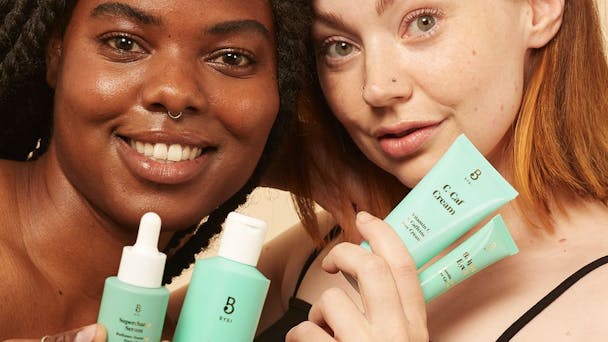Social media is changing how beauty brands market their products, bringing a wide array of new opportunities and challenges

In this latest article, we dive into how brands leverage social media to drive engagement and ultimately growth.
Social media can be considered the most effective marketing channel for beauty brands, as over 40% of consumers are more likely to discover (and search for) new products via social media. Furthermore, social media allows them to get insights into consumer reviews in a few different ways: through comments on social media, blogger's posts, and celebrity endorsements. Moreover, more than 45% of consumers state they mainly look for consumer reviews before making a purchase.
Increased activity on social platforms enables consumers to communicate with brands and voice their opinions, this pressures brands to give their views on important topics from animal cruelty and sustainability, to societal issues.
Consumers are more aware of how their lifestyle habits influence the environment and they demand to know how their favourite brands are impacting the environment too. To put it into a perspective: around 81% of consumers want their favourite brands to offer eco-friendly products and the same number of them state they'd be motivated to purchase if they knew that product or a company is environmentally friendly.
Furthermore, social media raises awareness around the lack of diversity and inclusivity. Brands should use social media to convey a positive message and engage their communities in conversations.
Beauty brands have leveraged the popularity of social media and brought their shops to consumers instead of the other way around. Now, social media platforms such as Instagram and Facebook serve as virtual stores, with feeds functioning as virtual storefronts.
Each social media platform requires a different approach
While every social media platform has a common goal of building community and allowing brands to communication directly with consumers, social media advertising is different for each platform, as they function differently and attract different audiences. This is how brands have to adjust their advertising for each platform:
1. TikTok
TikTok is probably one of the hottest channels for marketing beauty brands today. Contrary to popular belief, TikTok is not only targeted to a younger audience with 42% of users aged between 30-49. TikTok is built on short-form video with 60-second format videos performing well for beauty brands. Keep in mind that longer-form videos and live streams are also increasingly popular.
For brands to succeed on TikTok, they should produce informative and entertaining videos that will show what the product is and clearly define its benefits.
2. Instagram
90% of all social media posts relating to beauty are posted on Instagram, the Meta platform is by far the most popular social network for beauty brands. Instagram is a visual network that also offers rich text explanations and shorter video formats including tutorials. Brands can use it to showcase before and after transformations, for influencer reviews, user testimonials, and so on.
Thanks to social media resellers, brands now offer the possibility of effortless global shopping, avoiding the costs of shipping and import charges.
Brands can tag products on Instagram posts. Look at Sephora's Instagram feed, for instance, where followers can shop by clicking on tagged products from within ads posted on the feed.
Social media platforms have recognised this trend and now offer a wider array of features that promote selling on the platform: From Shoppable pins on Instagram Posts to tagged products shareable on Instagram Stories, with a CTA.
3. Pinterest
Pinterest is a powerful search and discovery tool that can help brands "humanise" their brand by sharing inspiring boards, usually in the same way a customer would. Furthermore, on this platform brands can highlight new trends and show inspiration and best practices showcasing customers a roadmap to success.
4. YouTube
75 hours of beauty content is uploaded on YouTube daily, so it's easy to see why it's still a powerful platform for beauty brands. YouTube hosts longer videos (around 20 minutes) where YouTubers show their honest reviews and experiences with a product, helping consumers make the best purchasing decision. The main benefit of YouTube & working with YouTubers is that viewers generally have high trust in video content that is posted on the platform, any heavy branding may have an adverse effect, hence it is important to work with creators and influencers when publishing on YouTube.
“Social platforms have dramatically reduced the barrier to entry for new beauty brands to launch, which means there is a huge opportunity and high competition. With algorithms constantly changing it's become increasingly hard to get cut through. We see the biggest opportunity in partnering with content creators who are aligned with our brand values and have an audience who would genuinely be interested in our products. This doesn't always mean choosing those with the biggest followings; it's more about brand alignment and working with people who actually love your products and what you do. We definitely see the biggest opportunity to do this is on TikTok as a growing platform.”
Opportunities for beauty brands
So how can you succeed on social media? We provide some examples of strategies that can be implemented to ensure greater chances of success:
High-Quality Influencer selection
It shouldn't be news to you, but brands can achieve great success by working with influencers. However, choosing the right ones to market their brand can seem like a daunting task.
To make the best possible choice, brands should first define their campaign goals: is it brand awareness, content creation, or a sales ? When they define the campaign objectives, they'll know how they want to collaborate with influencers. For instance, if the objective is to create content, brands should focus on finding influencers whose content quality aligns with their brand and base their decision making on the engagement rate of their posts/
Relevance is also important when choosing the right influencer. Brands should pick influencers that align with their brand's values. The best way to gauge whether an influencer is a good fit or not, is to imagine them marketing your product.
Lastly, brands should pay attention to authenticity. Authentic creators have better chances of promoting your brand since they have a more dedicated following. The best way to determine an influencer's authenticity is to scroll down to both paid and non-paid posts. If there's little to no difference between these posts, you're on a good place.
Livestream Sessions
Consumers want to communicate directly with the brand and get answers to their questions immediately. This is why live sessions are useful, as they allow companies to respond to every question about the product and create an "in-store" experience. Live sessions can be held either by experts or affiliated influencers.
Short Video Tutorials
As is the case with Instagram and TikTok videos, tutorials are essential for a brand's success as they showcase what their product is all about, and what it can do. Short videos can be made with influencers, and places across all key social media platforms, from Meta to TikTok.
Employee Influencers
Employee influencer programs are a great extension of consumer influencers, as it enables beauty companies to share honest testimonials about their products, as well as to legitimize their voice through relatable content.
Sunday Riley is a great example of this practice since they share their stories through the #SundaySkin series, where members of their team share pro tips on their products.
Founder Influencers
Just like with employee influencers, founder influencers are a great way for smaller brands to advertise their brands. It's a way for beauty brands to gain some legitimacy and consumer trust, given their founder vouches for them and shares relatable testimonials about products.
User Generated Content
Consumers want brands to be more transparent and they actively seek a user-centric experience. This is why more than 70% of Gen Zs and Millennials state it's important for brands to provide them with a more personalised experience.
UGC is great for brands as it pushes consumers to purchase a product with a little social proof, presents the product as it is, and demonstrates its benefits. Furthermore, UGC reveals diverse people behind the product which is something consumers are seeking.
Brand partnerships
Brand collaborations allow companies to reach new customers, promote a cause, and increase social media engagement. What's more, brand collaborations can be up to 25 times cheaper than paid digital media.
A Clear Strategy
The key to marketing success hides in consistency. Consumers want to meet the brand and get familiar with it, and this is only possible if the brand strategy is consistent and sends the same message throughout the posts. That said, brands should strive towards unifying their message and becoming recognizable by their voice, visual identity, messages they send, etc.
Get ready for the exciting and limitless possibilities that media has to offer to engage communities. Reach out to the team at Hey Honey to find out more.

